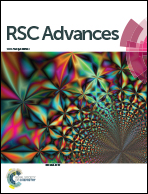TiO2-decorated porous carbon nanofiber interlayer for Li–S batteries
Abstract
Lithium–sulfur (Li–S) batteries are the most promising energy storage systems owing to their high energy density. However, shuttling of polysulfides detracts the electrochemical performance of Li–S batteries and thus prevents the commercialization of Li–S batteries. Here, TiO2@porous carbon nanofibers (TiO2@PCNFs) are fabricated via combining electrospinning and electrospraying techniques and the resultant TiO2@PCNFs are evaluated for use as an interlayer in Li–S batteries. TiO2 nanoparticles on PCNFs are observed from SEM and TEM images. A high initial discharge capacity of 1510 mA h g−1 is achieved owing to the novel approach of electrospinning the carbon precursor and electrospraying TiO2 nanoparticles simultaneously. In this approach TiO2 nanoparticles capture polysulfides with strong interaction and the PCNFs with high conductivity recycle and re-use the adsorbed polysulfides, thus leading to high reversible capacity and stable cycling performance. A high reversible capacity of 967 mA h g−1 is reached after 200 cycles at 0.2C. The cell with the TiO2@PCNF interlayer also delivers a reversible capacity of around 1100 mA h g−1 at 1C, while the cell without the interlayer exhibits a lower capacity of 400 mA h g−1. Therefore, this work presents a novel approach for designing interlayer materials with exceptional electrochemical performance for high performance Li–S batteries.

- This article is part of the themed collection: Celebrating recent achievements in chemical science in Turkey


 Please wait while we load your content...
Please wait while we load your content...